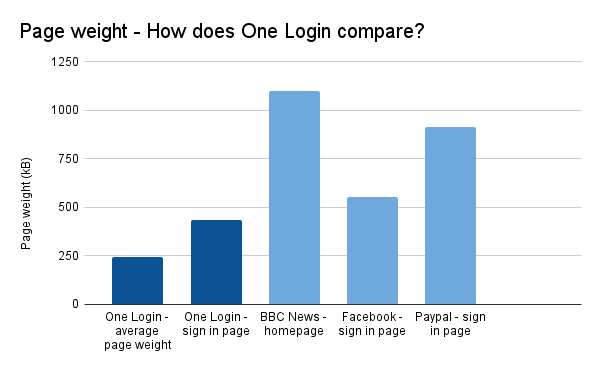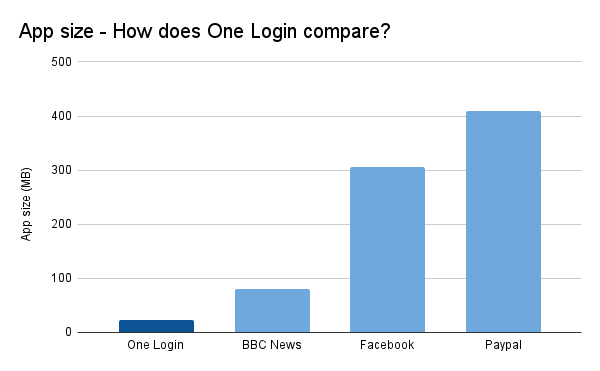
I wanted to update you on an aspect of our work in GOV.UK One Login that we haven’t really talked about before, our drive to make it one of the most sustainable government digital services in operation.
As part of our work to design the solution, we started to take a real interest in how different technical and style choices have a direct impact on carbon emissions. And when we really started to look at it in detail we realised how much work has been done in this space and yet how hard it still was to get a definitive ‘how to’ guide from anywhere if you want to start to calculate the carbon footprint of your digital service.
My deepest thanks to colleagues in Defra and our partnering organisations who have invested time (and patience) with us, helping us to understand the issues, the tools and principles we need to put into practice to be able to both measure a footprint but also to evaluate the effect of any future changes we might implement as a result.
How we started our green journey
OK, some technical bits, for those of you that already know this, please bear with me. Calculating your emissions or your sustainability is as much art as science and in order to make any tangible progress you have to draw a ring around the things you’re trying to measure and influence.
For us this meant focussing on the greening of digital services not greening by digital services. Sounds similar right? They’re actually quite different. We've decided to focus on how we can make the digital tech we’re building as sustainable as possible, rather than trying to calculate the emissions saved by people being able to complete things online rather than perhaps taking a bus to complete a face to face interaction.
We’ve defined our ‘digital service’ as a combination of data centres and hosting, networks and end user devices, both those used by us to build and run the service but also those used by citizens when they access it.
Then we set about trying to measure our emissions and started to run experiments in areas to see whether changes to a design, or implementation can reduce our carbon emissions.
It’s taken us nearly four months to get a baseline! We built an app in less time than that! Which goes to show how hard it’s been to get data, and tooling and figure out how to come up with numbers that are robust. We think our numbers are probably under estimates and we’ll continue to refine them.
Understanding our digital emissions
We think One Login’s annual digital emissions are currently roughly ~200 tonnes of CO2e but this will grow as the user base grows, likely from hundreds to thousands of tonnes of CO2e. It is not easy to compare One Login’s carbon emissions to other web services as they are driven by a number of factors. However there are a number of other data points that we can use to compare One Login to other services.
Two of these data points are website page weight and mobile app size that indicate the amount of data transferred when using One Login (on the web or the app). The amount of data transfer impacts the amount of energy used to interact with the service, therefore impacting the overall carbon emissions attributed to citizens for using the service. Although it’s not as simple as saying lower data transfer leads to lower emissions, it is a useful data point to estimate the emissions of web services and to compare One Login to others.
One Login has relatively low page weights and app sizes as the comparison to other services below shows. Of course One Login has a different use case to these sites, however this still illustrates that we think we aren’t doing too badly.


So now we have a baseline, we are starting to build out a prioritised roadmap of activities to reduce our carbon emissions and put in place better tools to monitor emissions on an ongoing basis. Some examples of activities we are considering to reduce One Login’s emissions include: hosting assets (e.g. images and fonts) on shared domain so the user only has to download the assets to their device once, ensuring all our computing workloads scale dynamically, removing some unused cloud assets and implementing better data classification and use policies to minimise unnecessary data storage.
Next we’re rolling onto our neighbours in GOV.UK to run a similar exercise on GOV.UK itself. So exciting! Let’s hope we can shave a couple of months off our previous measurement time.
Future proofing green IT
As the SRO for GOV.UK One Login I’m really passionate about understanding how we can make sustainability one of the factors all government digital teams consider when they’re making design or technical choices. In GOV.UK One Login we have the glimmer of an idea that in order to do this teams will need a set of simple tools and processes they can apply and as we collaborate with GOV.UK teams on calculating their footprint we’ll be adding to our lessons learned around how to measure things effectively and efficiently.
I’m hoping we’ll have much more to share on our journey into green digital over the coming months and years but for now… if you’re out there and you’re reading this and you’ve done work in this area and have tips, tools, how to guides or ideas about how to help please do get in touch with the Green IT Team so we can share ideas and move forwards together.
Natalie Jones
Please get in touch with green@digital.cabinet-office.gov.uk if you have any green ideas or insights.


6 comments
Comment by Steve Messer posted on
This is fabulous!
I would love to see one of GDS’s leaders play a part in W3C’s Sustainable Web Design community group (https://www.w3.org/community/sustyweb/), particularly to play a part in the Web Sustainability Guidelines that will be published as a draft shortly (https://www.w3.org/blog/2023/introducing-web-sustainability-guidelines/). The organisation has played such a major role in shaping some of the accessibility guidelines and I’m sure it can lend some insight to the sustainability guidelines too.
It’ll be a huge factor in making sure that teams consider sustainability as a factor when making design and technical choices, so I hope it’ll suit your passion. Natalie.
Comment by Jamie Dixon posted on
This is really good work and I'm sure it will have a big impact with the volume of traffic across GOV.UK. We've been looking at this for a while across all of our digital activity.
Anything you can share via the Design system will be really useful for public sector websites.
If you haven't come across it already, Gerry McGovern is doing some brilliant work to raise awareness of the environmental impact of Digital. Take a look at gerrymcgovern.com.
Comment by Steve posted on
Good to see this being thought about.
A couple of thoughts...
1. It is interesting you mention the devices being used by the team were within scope - was consideration given to including the emissions generated by members of the team getting to a point where they could do the work e.g. commuting or not (if remote)?
2. Was the choice of language/framework used to develop the service considered with emissions in mind?
(there are lots of factors in making this choice that could also impact on emissions even if the most efficient language was used e.g. time to do the development, researching, learning, training, debugging, testing, etc.)
3. How closely could the cost of running the service be used as a proxy to emissions? The future activities mentioned are (IME) more commonly done in order to increase efficiency and reduce costs which just so happens to reduce energy use as that is part of the cost.
Given energy costs are part of the cost of everything, in theory, the cheaper the cost of running the service, the lower the amount of energy used. Admittedly this wouldn't cover emissions generated by users but if the cost of delivering the service to users is targeted to be as low as possible (without going to the extreme to game the system) one would imagine that would mean the smallest amount of network traffic would be sent in the shortest time possible which would in turn mean the user's device did the least amount of work as possible.
Perhaps there are scenarios where this wouldn't work e.g. if you had a rich client app that did all the heavy lifting and computation off the back of small data responses that could be a low cost service to run.
Comment by Natalie Jones OBE posted on
Hi Steve,
Thank you for your question.
1. Yes - consideration was given to areas such as employee commuting, however for this footprint, it was decided that areas outside of One Login’s IT systems, would be excluded. The focus for now is measuring the IT-related emissions of the service, however, as we continue to measure our emissions, we will continue to refine our approach to determine whether it remains appropriate.
2. Like lots of services, the impact on emissions of the language/framework wasn’t an initial consideration in the decisions on language/framework, however, moving forward, we want it to be. We’ve also made changes in some areas where using a different language would have an impact so we’re starting to put that upfront thinking into practice.
3. The cost of running the service is definitely a useful rough proxy for the amount of energy used and hence emissions, however, there are cost items which do not directly correlate to energy consumption (e.g. IT tax and admin services) and energy consumption doesn’t necessarily correlate to emissions (emissions will vary based on energy sources). We are working with our cloud and IT suppliers to identify ways to understand One Login’s energy consumption more comprehensively.
Thanks,
Natalie
Comment by Mark Gwilliam posted on
Could you elaborate on why the BBC / Facebook / PayPal chosen for comparison? - none of these are identity providers
Comment by Natalie Jones OBE posted on
Hi Mark,
Thank you for your question. These services were chosen for the following reasons:
1. They are well-known service providers, where functionality of the service is likely to be understood by the general public.
2. These services have both an app and a website, similar to One Login.
3. The services have both public web pages, and web pages that require a login, similar to One Login.
Thanks,
Natalie